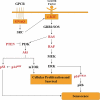Current state of melanoma diagnosis and treatment
- PMID: 31366280
- PMCID: PMC6804807
- DOI: 10.1080/15384047.2019.1640032
Current state of melanoma diagnosis and treatment
Abstract
Melanoma is the deadliest form of skin cancer. In the early stages, melanoma can be treated successfully with surgery alone and survival rates are high, but after metastasis survival rates drop significantly. Therefore, early and correct diagnosis is key for ensuring patients have the best possible prognosis. Melanoma misdiagnosis accounts for more pathology and dermatology malpractice claims than any cancer other than breast cancer, as an early misdiagnosis can significantly reduce a patient's chances of survival. As far as treatment for metastatic melanoma goes, there have been several new drugs developed over the last 10 years that have greatly improved the prognosis of patients with metastatic melanoma, however, a majority of patients do not show a lasting response to these treatments. Thus, new biomarkers and drug targets are needed to improve the accuracy of melanoma diagnosis and treatment. This article will discuss the major advancements of melanoma diagnosis and treatment from antiquity to the present day.
Keywords: Melanoma; diagnosis; epigenetics; immunohistochemistry; immunotherapy; treatment.
Figures


References
Publication types
MeSH terms
Substances
Grants and funding
LinkOut - more resources
Full Text Sources
Medical
Research Materials
